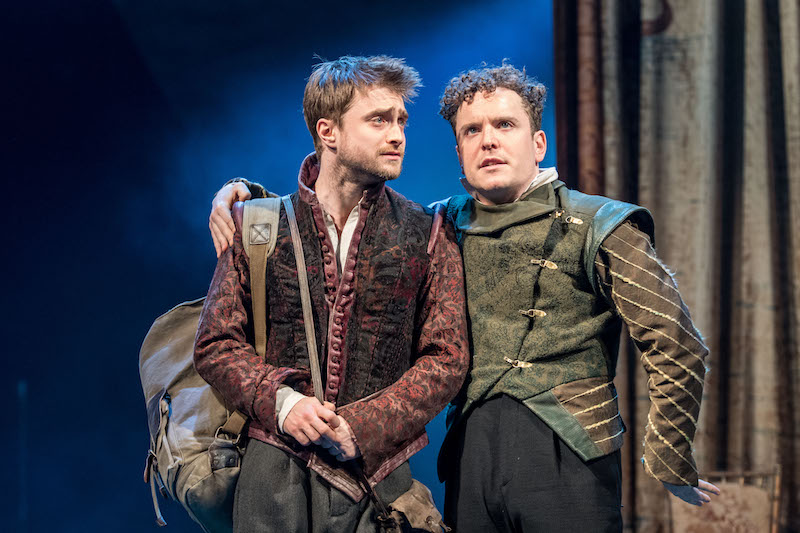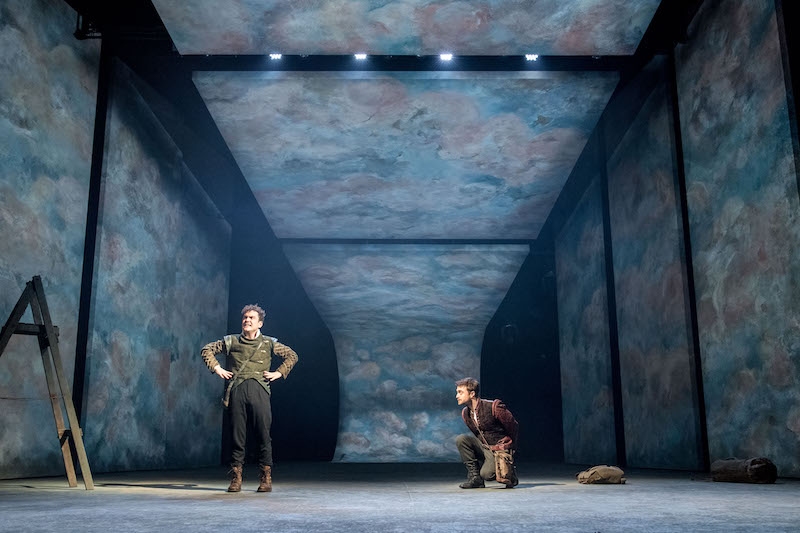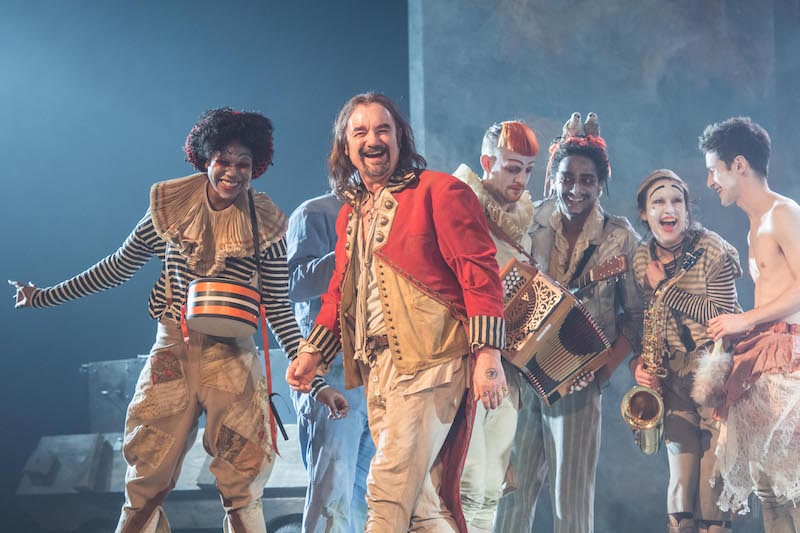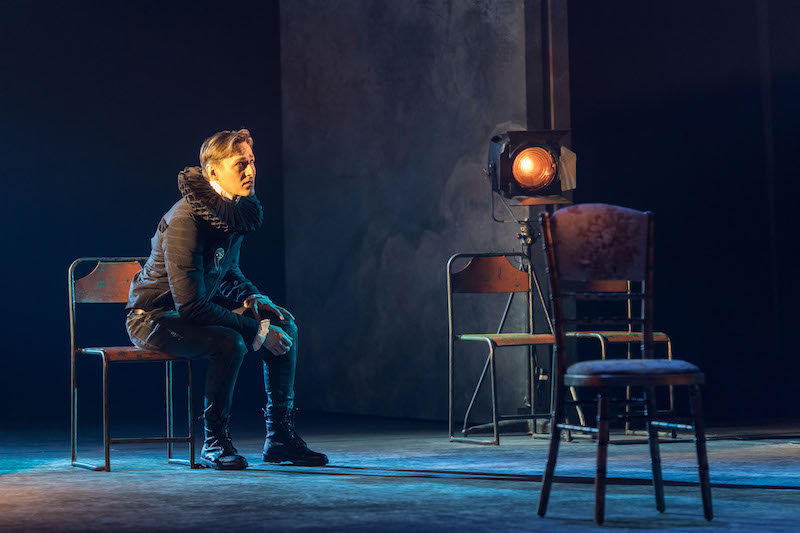Rosencrantz and Guildenstern are Dead is the play that shot Tom Stoppard to overnight fame, annointing him as the young rock star of British playwriting. The audacious, absurdist drama premiered in Edinburgh in 1966 and transferred to the National Theatre – then based at London’s Old Vic – the following year. So, it seems particularly apt that the Old Vic should produce a 50th anniversary production on the same stage.
 Daniel Radcliffe and Joshua McGuire. Photograph © Manuel Harlan
Daniel Radcliffe and Joshua McGuire. Photograph © Manuel Harlan
Now audiences around the world have the chance to see it via NT Live (screening here in Australia thanks to Sharmill Films). It’s the first time that an Old Vic production has been part of NT Live, and a wonderful opportunity for Australians to see a production that has been so highly acclaimed in London.
You can’t help but marvel that the Czechoslovakian-born Stoppard was still only in his mid-20s when he wrote Rosencrantz and Guildenstern are Dead. An existential riff on Shakespeare’s Hamlet, which also references Beckett’s Waiting for Godot, it is full of dazzling verbal and intellectual gymnastics, as well as meta-theatrical games, with double entendres, puns, witticisms, word games and allusions aplenty.
The play centres on the two minor characters from Shakespeare’s tragedy, university friends of Hamlet’s who have been summoned to Elsinore to try to find out why he is so melancholy. Trapped in a world they don’t understand, with no knowledge about where they’ve come from or what they are there to do (they only know what we learn about them in Shakespeare’s play), they anxiously while away the time.
As they wait for something to happen – like Vladimir and Estragon in Godot – the rest of Shakespeare’s play is unfolding elsewhere, occasionally spilling onto the stage around the hapless duo as events beyond their control hurtle them towards their fate.
 Joshua McGuire and Daniel Radcliffe. Photograph © Manuel Harlan
Joshua McGuire and Daniel Radcliffe. Photograph © Manuel Harlan
The title roles in the Old Vic production are played by Daniel Radcliffe (of Harry Potter fame) and Joshua McGuire. At the start of the screening the two of them lead us backstage by way of introduction. Entering the rehearsal room Radcliffe wryly admits that initially they had to “get over the existential crisis of performing Tom Stoppard’s words in front of Tom Stoppard.” And then after a brief stop-over front of house, the show begins.
The production, which was directed by David Leveaux, had mostly excellent reviews. If I’m not quite as bowled over by it as some of the British critics it’s because the Sydney Theatre Company’s 2013 production, directed by Simon Phillips and starring Toby Schmitz and Tim Minchin, is still pretty fresh in my mind, and for my money that had an edge over the Old Vic’s.
Staged on Gabriela Tylesova’s stunningly surreal, menacing set – a steeply raked stage flanked by sharply converging black walls that led to a vanishing point in the void, while three arched tunnels down each side played tricks with our perception – Schmitz and Minchin created incredibly vivid, idiosyncratic characters.
Schmitz’s flamboyant, cocky Guildenstern had a keen awareness of their existential plight and an increasingly desperate bravado as their fate loomed, while Minchin’s Rosencrantz was an innocent, gentle, naïve, clown-like soul with a deep-seated anxiety. The contrast between them was more pronounced than in the Old Vic production, which gave the play more of a lively dynamic. They also made us really care about the two hapless characters.
 David Haig as The Player with other cast members. Photograph © Manuel Harlan
David Haig as The Player with other cast members. Photograph © Manuel Harlan
McGuire and Radcliffe don’t create such memorable characters but they both deliver sound performances, bouncing well off each other. Radcliff’s role choices in the wake of Harry Potter have been so interesting – from the lead role in Peter Shaffer’s stage play Equus to a farting corpse in the film Swiss Army Man – and it’s fascinating to see him tackling a play like this.
The stand-out, however, is David Haig as The Player, playing him as a seedy, Vincent Crummles-like veteran actor-manager with a rough-and-ready, mongrel energy. His death scene is gloriously over the top. And how great to see Australian actor Luke Mullins in the cast as Hamlet, played with a self-absorbed aloofness.
 Luke Mullins as Hamlet. Photograph © Manuel Harlan
Luke Mullins as Hamlet. Photograph © Manuel Harlan
We’re told by Radcliffe and McGuire in the introduction that several rows of seating were removed to bring the stage forward and give it extra depth so that Rosencrantz and Guildenstern look smaller in the vast space. Anna Fleischle’s evocative set also plays with perspective, with panels painted with clouds framing the stage and creating the illusion of it stretching back miles, while also giving the space a slightly sinister quality.
Fifty years on, Stoppard’s wit still dazzles even though there are some longueurs in the play. You could hear the live audience laughing at things that didn’t translate in the cinema but there are wonderfully funny touches such as the way McGuire and Radcliffe stand frozen against one of the cloudy panels hoping that it makes them invisible.
Funniest of all is the moment when Rosencrantz and Guildenstern try to intercept Hamlet after he has killed Polonius, only for Hamlet to appear dragging the body on a sheet and suddenly veer off into the wings before reaching the trap they’ve set. Hilarious.
Rosencrantz and Guildenstern are Dead screens at 60 locations around the country from June 24











Comments
Log in to join the conversation.